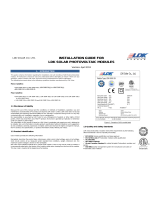Sennheiser SK 50-A User manual
- Category
- Battery chargers
- Type
- User manual
This manual is also suitable for
Sennheiser SK 50-A is a bodypack transmitter for wireless transmission of sound to a receiver. It can be used with lavalier microphones, headworn microphones or instruments. The transmitter is equipped with a rugged metal housing and features an easy-to-read backlit display. The SK 50-A has an operating range of up to 330 feet (100 meters) and offers up to 12 hours of battery life on two AA batteries. The transmitter is also equipped with a variety of features, including:
- Adjustable output power
- Selectable RF frequencies
- Mute function
- Auto-lock function
The Sennheiser SK 50-A is a versatile and reliable bodypack transmitter that is perfect for a wide range of applications, including:
Sennheiser SK 50-A is a bodypack transmitter for wireless transmission of sound to a receiver. It can be used with lavalier microphones, headworn microphones or instruments. The transmitter is equipped with a rugged metal housing and features an easy-to-read backlit display. The SK 50-A has an operating range of up to 330 feet (100 meters) and offers up to 12 hours of battery life on two AA batteries. The transmitter is also equipped with a variety of features, including:
- Adjustable output power
- Selectable RF frequencies
- Mute function
- Auto-lock function
The Sennheiser SK 50-A is a versatile and reliable bodypack transmitter that is perfect for a wide range of applications, including:




















-
 1
1
-
 2
2
-
 3
3
-
 4
4
-
 5
5
-
 6
6
-
 7
7
-
 8
8
-
 9
9
-
 10
10
-
 11
11
-
 12
12
-
 13
13
-
 14
14
-
 15
15
-
 16
16
-
 17
17
-
 18
18
-
 19
19
-
 20
20
-
 21
21
-
 22
22
-
 23
23
-
 24
24
-
 25
25
Sennheiser SK 50-A User manual
- Category
- Battery chargers
- Type
- User manual
- This manual is also suitable for
Sennheiser SK 50-A is a bodypack transmitter for wireless transmission of sound to a receiver. It can be used with lavalier microphones, headworn microphones or instruments. The transmitter is equipped with a rugged metal housing and features an easy-to-read backlit display. The SK 50-A has an operating range of up to 330 feet (100 meters) and offers up to 12 hours of battery life on two AA batteries. The transmitter is also equipped with a variety of features, including:
- Adjustable output power
- Selectable RF frequencies
- Mute function
- Auto-lock function
The Sennheiser SK 50-A is a versatile and reliable bodypack transmitter that is perfect for a wide range of applications, including:
Ask a question and I''ll find the answer in the document
Finding information in a document is now easier with AI
Related papers
-
Sennheiser EK 3041-U Owner's manual
-
Sennheiser 503167 Datasheet
-
Sennheiser EK 3241 User manual
-
Sennheiser Wireless RS 45 User manual
-
Sennheiser SKP 3000 User manual
-
Sennheiser EM 3032-U Owner's manual
-
Sennheiser EM 3532-U User manual
-
Sennheiser EM 3732-II User manual
-
Sennheiser EK 6042 User manual
-
Sennheiser EM 3732COM -II N User manual
Other documents
-
 LDK Solar LDK-160D-24s Installation guide
LDK Solar LDK-160D-24s Installation guide
-
GRASS VALLEY LDK 8000 User manual
-
Technicolor - Thomson 5400LDK User manual
-
RCA LDK 200 User manual
-
Viper LDK 7500 Specification
-
GRASS VALLEY LDK 8000 HDTV multi-standard, multi-format camera system User manual
-
Technicolor - Thomson 20(S) User manual
-
GRASS VALLEY LDK 4700 User manual
-
Technicolor - Thomson LDK 4502 User manual
-
LG Electronics LDK User manual

























